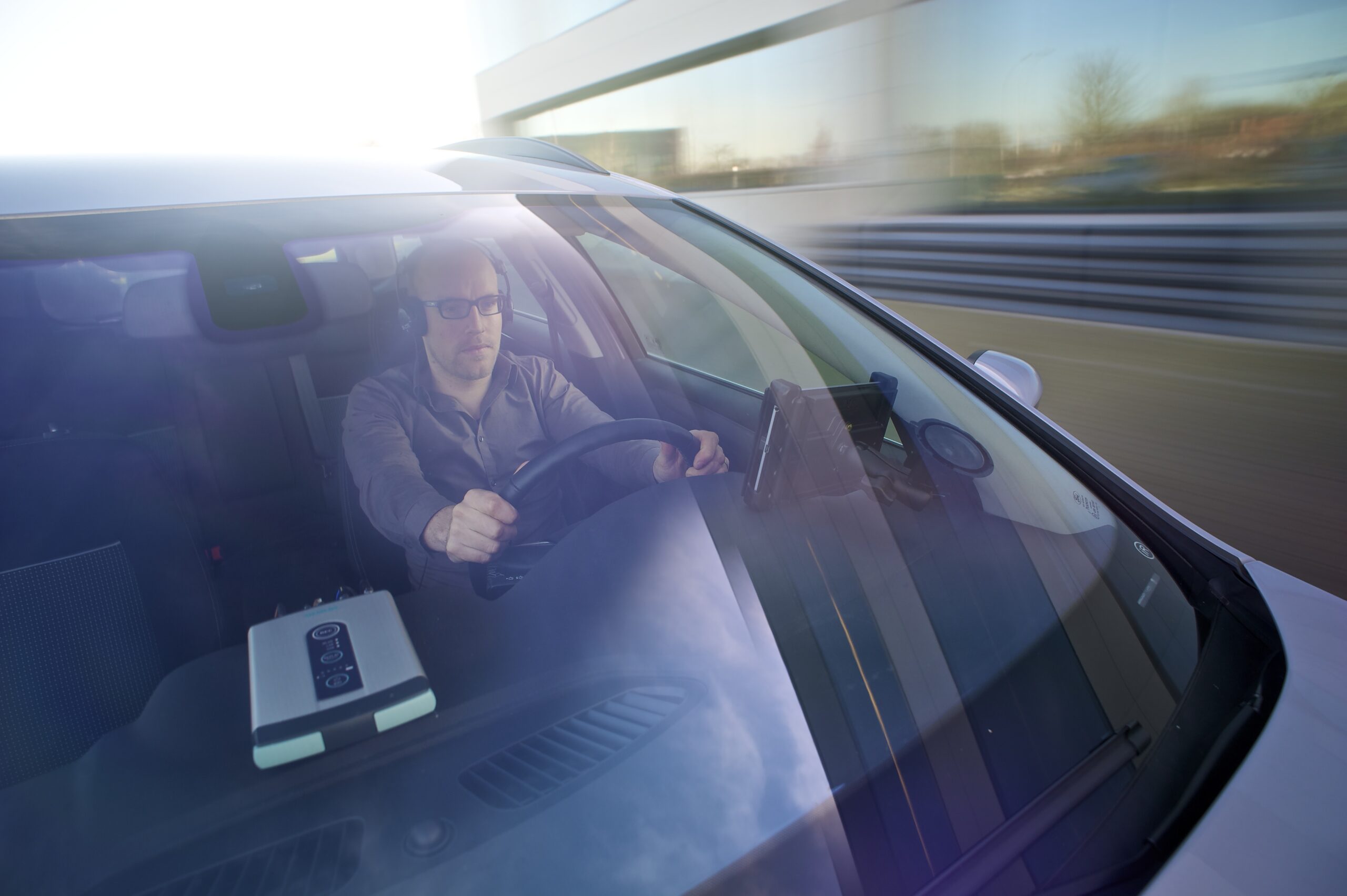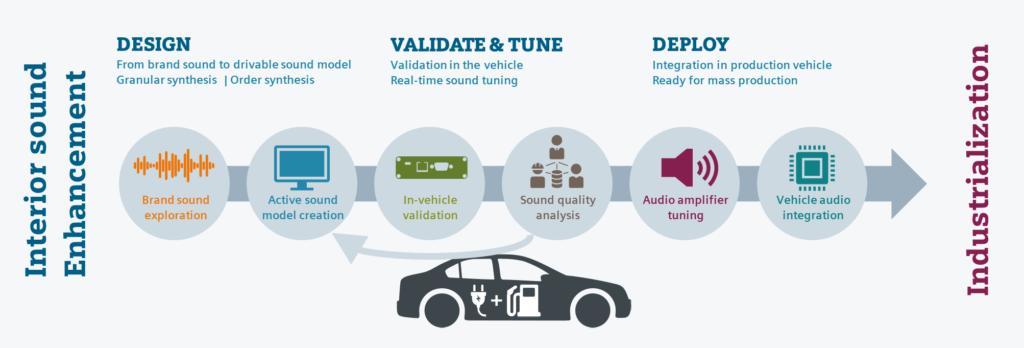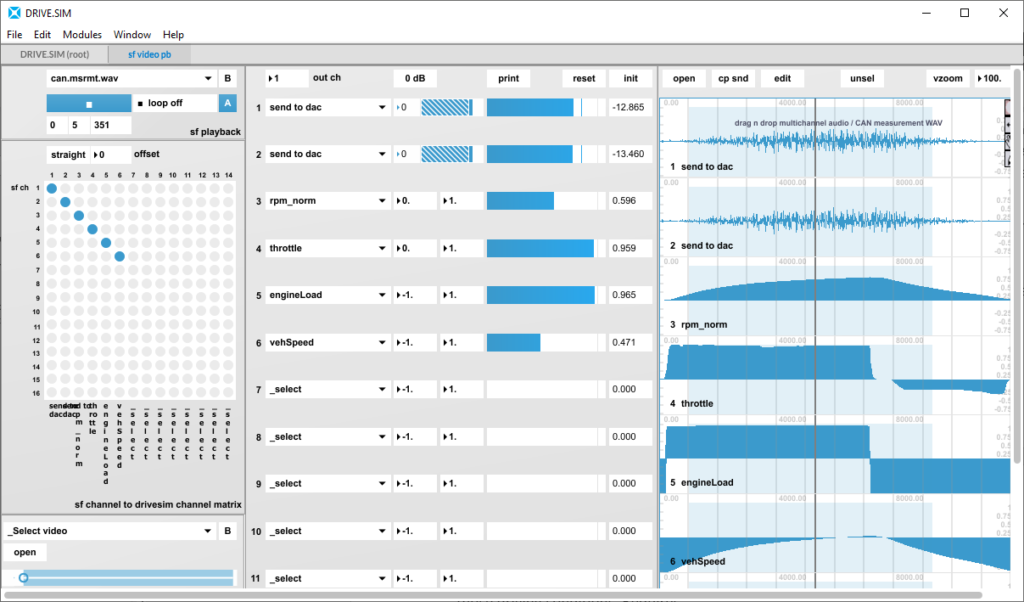Test-drive your car from home with active sound enhancement

Active sound design is the act of purposely generating sounds in a vehicle; to inform, warn, or please the driver and passengers. Active sound enhancement usually requires the acoustic engineer to test-drive the vehicle. In real driving conditions, the engineer assesses, tunes, and validates the desired brand sound as part of the overall sound landscape.
But what if there’s no car available? What if the only accessible prototype is a virtual one? Or if the sound engineer must work remotely and can’t board the car?
Record the real driving dynamic data and use it to tune and perfect the vehicle’s sound signature – virtually, with remote teams, foreign sound artists, or simply, from home.
Active sound enhancement of electric cars
Hybrid and electrical vehicles are increasingly popular, and so is the use of active sound enhancement techniques to perfect the cars’ sound design. And that’s mainly because e-vehicles are quieter… sometimes too quiet. Drivers miss the auditory feedback of a revving engine. Plus, they are annoyed by the dominance of other noises in the cabin, such as the tire and road noise, the wind noise, or the noise from the electric auxiliaries. Active sound design addresses all these issues. It generates sounds that bear meaning for the driver and improve the overall sound quality. This is not only about offering a pleasant cabin sound experience, but also about giving the driver adequate auditory feedback about the vehicle’s driving behavior.
Tuning active sound from home
Automotive development programs rely less and less on physical prototyping. Meanwhile, new workstyles emerge, where engineers work remotely out of flex offices, with global virtual teams, or even from home. And nobody parks an exclusive prototype in his/her private garage. Or sets up an expensive vehicle simulator on the kitchen table or in the study. Luckily, a simple desk and PC suffice to perform a large portion of active sound design, whichever the development stage.

The process of active sound design and enhancement
The first phase of active sound enhancement is the design stage. Acoustic engineers and sound designers start with exploring the unique brand sounds. They collect sound samples, survey consumers to understand the preferences of future drivers, and deduct the rules that define the vehicle’s unique sound signature. Should it be a predictable sound like the one of a combustion engine vehicle? Should it sound futuristic? Comforting? What are the sound quality metrics that define the targeted sound, which levels should the sound meet?
The engineers can then create an active sound model using a dedicated sound design tool, tailored for vehicle sound synthesis. Simcenter Testlab Sound Designer employs state-of-the-art methods to design and synthesize sounds, considering the vehicle’s driving dynamic parameters, such as speed, torque, and throttle position. It generates creative, natural, and rich sound signatures that appear natural.
Ever heard an elephant trumpeting? Hearing that sound ignites a full range of emotions: strength, control, power… As incredible as it seems, the trumpeting of an elephant makes for an excellent active sound signature, stimulating an exhilarating sensation of power and control with the driver when pressing the pedal.
In the second phase, the engineers must validate and tune the selected sound signature in real-life conditions. For that, they drive the vehicle around, testing it in various driving conditions (in urban traffic, with high and slow acceleration, on the motorway…), while listening to the synthesized sound signature being played over the vehicle’s speaker system. They adjust and fine-tune the sound signature accordingly and immediately evaluate the effects.
Relying on actual dynamic driving data
Now coming to the point: how can you tune and validate the sound signature if you don’t have the car? Without tuning, the sound signature would not have the expected effect on the driver. Yes, prototypes are scarce or inaccessible. Well, the key is to start with recording the noise and sounds in the driving conditions of interests. The Simcenter SCADAS XS data acquisition hardware records the required dynamic parameters – speed, torque, throttle, and rpm – from the vehicle’s CAN bus. It also captures the binaural recording of the sounds at the driver’s left and right ears. Technicians quickly and effortlessly proceed with the recording, driving one of the few prototype vehicles, or a so-called “mule” vehicle. The mule is usually a quiet vehicle selected for producing a low, neutral sound level.
Once the driving data is available, a dedicated Testlab Sound Designer module takes over. It imports the data and replays it in the sound studio, in the office, or on the home computer. Just as if he/she was in the car, the sound designer can tune and perfect the sound signature in real-time.
Listening to the binaural recording, the engineer can evaluate the driver’s perception of the active sounds, while being simultaneously exposed to the interior noise of the engine, tires, wind, and auxiliaries. He/she can audibly compare side-to-side the enhanced synthesized sound and the original vehicle sound.

The Simcenter Testlab Sound Designer DRIVE.SIM module replays the prerecorded drive profile.
Virtually enhancing the sound
Using real driving data, the engineer evaluates and tunes several design variants. He/she issues a shortlist of sound signatures for validation in the physical vehicle. Iterations took place off-road and even offline if required.
The final phase of the process is the deployment, where the final sound signature is deployed on and tuned to the selected tier-1 supplier of audio DSP hardware and speaker system. The active sound design is now ready for mass-production.
Finally, a large portion of the validation work takes place outside the car, virtually tuning the sounds at a desk. Any desk. Naturally, you still require a good sound card in your PC, along with outstanding headphones. But that’s all. The prototype vehicle remains available for other development tasks, while you tune and craft the active sound signature. Only at the very end do you need to check the sound signature in the vehicle. But this will only take a few days, instead of weeks. A final round of physical testing confirms that the sound you designed is the perfect brand sound for the production vehicle. Because whatever sound you design in the studio must eventually be evaluated in the real vehicle.
Are you eager to learn more about the technology? Read our blog article “all you need to know about vehicle active sound design”, or join the free on-demand webinar: “How to make remarkable sound of electrified vehicles inside out with active sound design”.


